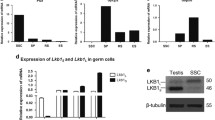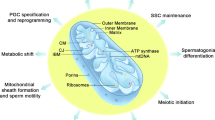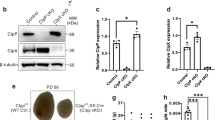Abstract
MTCH2 has been described in liver as a protein involved in the intrinsic apoptotic pathway, although new evidence also associates this protein with cellular metabolism. In this work, the expression of MTCH2 in testis (an organ in which high levels of apoptosis normally take place as part of the spermatogenic process) is analyzed in rat, both at the mRNA and at the protein levels. Our results showed that MTCH2 was highly expressed in testis compared with other tissues and was differentially expressed according to developmental stage and testicular cell type. Protein expression was initially detected during the first spermatogenic wave at the time of meiosis onset and its levels increased in adulthood, with the highest expression levels being detected in meiotic prophase I. Specific differences in MTCH2 expression levels at the various stages of the adult seminiferous epithelium were also observed. Co-staining with TUNEL revealed a differential MTCH2 staining pattern in TUNEL-positive cells, mainly in dying primary spermatocytes, i.e., meiotic prophase I cells. Furthermore, upon mild hyperthermia (treatment shown to increase apoptosis in testis), MTCH2 levels rose concomitantly with a massive appearance of TUNEL-positive cells within the seminiferous tubules; these cells exhibited a differential MTCH2 distribution. Thus, MTCH2 is related to testicular apoptosis, especially during meiotic prophase.







Similar content being viewed by others
Abbreviations
- CRBC:
-
Chicken red blood cells
- DD:
-
mRNA differential display
- MCs:
-
Mitochondrial carriers
- MTCH2:
-
Mitochondrial carrier homolog 2
- OMM:
-
Outer mitochondrial membrane
- PCD:
-
Programmed cell death
- PI:
-
Propidium iodide
- tBID:
-
Truncated BID
- TBST:
-
TRIS-buffered saline with Tween
- TNF:
-
Tumor necrosis factor
- UTR:
-
Untranslated region
- RT-PCR:
-
Reverse transcription with the polymerase chain reaction
- qRT-PCR:
-
Quantitative real-time reverse transcription polymerase chain reaction
- HPRT:
-
Hypoxanthine guanine phosphoribosyl transferase
- BSA:
-
Bovine serum albumin
- DAPI:
-
4,6-Diamidino-2-phenylindole
- TUNEL:
-
Terminal deoxynucleotidyl transferase-mediated dUTP nick-end labeling
- PBS:
-
Phosphate-buffered saline
References
Aitken RJ, Findlay JK, Hutt KJ, Kerr JB (2011) Apoptosis in the germ line. Reproduction 141:139–150
Allan DJ, Harmon BV, Kerr JFR (1992) Cell death in spermatogenesis. In: Potten CS (ed) Perspectives on mammalian cell death. Oxford University Press, London, pp 229–258
Alsheimer M, Benavente R (1996) Change of karyoskeleton during mammalian spermatogenesis: expression pattern of nuclear lamin C2 and its regulation. Exp Cell Res 228:181–188
Andersen JL, Kornbluth S (2013) The tangled circuitry of metabolism and apoptosis. Mol Cell 49:399–410
Arigoni M, Barutello G, Riccardo F, Ercole E, Cantarella D, Orso F, Conti L, Lanzardo S, Taverna D, Merighi I, Calogero RA, Cavallo F, Quaglino E (2013) miR-135b coordinates progression of ErbB2-driven mammary carcinomas through suppression of MID1 and MTCH2. Am J Pathol 182:2058–2070
Bunea M, Zarnescu O (2001) New current aspects on the immunohistochemical techniques. Roum Biotechnol Lett 6:177–207
Capoano CA, Wettstein R, Kun A, Geisinger A (2010) Spats 1 (Srsp1) is differentially expressed during testis development of the rat. Gene Expr Patterns 10:1–8
De Vos K, Goossens V, Boone E, Vercammen D, Vancompernolle K, Vandenabeele P, Haegeman G, Fiers W, Grooten J (1998) The 55-kDa tumor necrosis factor receptor induces clustering of mitochondria through its membrane-proximal region. J Biol Chem 273:9673–9680
Domínguez F, Cejudo FJ (2012) A comparison between nuclear dismantling during plant and animal programmed cell death. Plant Sci 197:114–121
Edwalds-Gilbert G, Veraldi KL, Milcarek C (1997) Alternative poly(A) site selection in complex transcription units: means to an end? Nucleic Acids Res 25:2547–2561
Geisinger A, Rodríguez-Casuriaga R (2010) Flow cytometry for gene expression studies in mammalian spermatogenesis. Cytogenet Genome Res 128:46–56
Geisinger A, Wettstein R, Benavente R (1996) Stage-specific gene expression during rat spermatogenesis: application of the mRNA differential display method. Int J Dev Biol 40:385–388
Geisinger A, Alsheimer M, Baier A, Benavente R, Wettstein R (2005) The mammalian gene pecanex 1 is differentially expressed during spermatogenesis. Biochim Biophys Acta 1728:34–43
Grinberg M, Schwarz M, Zaltsman Y, Eini T, Niv H, Pietrokovski S, Gross A (2005) Mitochondrial carrier homolog 2 is a target of tBID in cells signaled to die by tumor necrosis factor alpha. Mol Cell Biol 25:4579–4590
Hammer O, Harper DAT, Ryan PD (2001) Past: paleontological statistics software package for education and data analysis. Palaeontol Electron 4:1–9
Huang B, Belharazem D, Li L, Kneitz S, Schnabel PA, Rieker RJ, Körner D, Nix W, Schalke B, Müller-Hermelink HK, Ott G, Rosenwald A, Ströbel P, Marx A (2013) Anti-apoptotic signature in thymic squamous cell carcinomas—functional relevance of anti-apoptotic BIRC3 expression in the thymic carcinoma cell line 1889c. Front Oncol 3:316. doi:10.3389/fonc.2013.00316
Jahnukainen K, Chrysis D, Hou M, Parvinen M, Eksborg S, Söder O (2004) Increased apoptosis occurring during the first wave of spermatogenesis is stage-specific and primarily affects midpachytene spermatocytes in the rat testis. Biol Reprod 70:290–296
Katz C, Zaltsman-Amir Y, Mostizky Y, Kollet N, Gross A, Friedler A (2012) Molecular basis of the interaction between proapoptotic truncated BID (tBID) protein and mitochondrial carrier homologue 2 (MTCH2) protein: key players in mitochondrial death pathway. J Biol Chem 287:15016–15023
Kim JH, Park SJ, Kim TS, Park HJ, Park J, Kim BK, Kim GR, Kim JM, Huang SM, Chae JI, Park CK, Lee DS (2013) Testicular hyperthermia induces unfolded protein response signalling activation in spermatocyte. Biochem Biophys Res Commun 434:861–866
Kleene KC (2001) A possible meiotic function of the peculiar patterns of gene expression in mammalian spermatogenic cells. Mech Dev 106:3–23
Kroemer G, Galluzzi L, Brenner C (2007) Mitochondrial membrane permeabilization in cell death. Physiol Rev 87:99–163
Kroemer G, Galluzzi L, Vandenabeele P, Abrams J, Alnemri ES, Baehrecke EH, Blagosklonny MV, El-Deiry WS, Golstein P, Green DR, Hengartner M, Knight RA, Kumar S, Lipton SA, Malorni W, Nuñez G, Peter ME, Tschopp J, Yuan J, Piacentini M, Zhivotovsky B, Melino G, Nomenclature Committee on Cell Death 2009 (2009) Classification of cell death: recommendations of the Nomenclature Committee on Cell Death 2009. Cell Death Differ 16:3–11
Kulyté A, Rydén M, Mejhert N, Dungner E, Sjölin E, Arner P, Dahlman I (2011) MTCH2 in human white adipose tissue and obesity. J Clin Endocrinol Metab 96:1661–1665
Laemmli UK (1970) Cleavage of structural proteins during the assembly of the head of bacteriophage T4. Nature 227:680–685
Li H, Zhu H, Xu CJ, Yuan J (1998) Cleavage of BID by caspase 8 mediates the mitochondrial damage in the Fas pathway of apoptosis. Cell 94:491–501
Lue YH, Sinha Hikim AP, Swerdloff RS, Im P, Taing KS, Bui T, Leung A, Wang C (1999) Single exposure to heat induces stage-specific germ cell apoptosis in rats: role of intratesticular testosterone on stage specificity. Endocrinology 140:1709–1717
Luo X, Budihardjo I, Zou H, Slaughter C, Wang X (1998) Bid, a Bcl2 interacting protein, mediates cytochrome c release from mitochondria in response to activation of cell surface death receptors. Cell 94:481–490
Malkov M, Fisher Y, Don J (1998) Developmental schedule of the postnatal rat testis determined by flow cytometry. Biol Reprod 59:84–92
Matsudaira P (1987) Sequence from picomole quantities of proteins electroblotted onto polyvinylidene difluoride membranes. J Biol Chem 262:10035–10038
Meistrich ML (1977) Separation of spermatogenic cells and nuclei from rodent testes. Methods Cell Biol 15:15–54
Meuwissen RL, Offenberg HH, Dietrich AJ, Riesewijk A, van Iersel M, Heyting C (1992) A coiled-coil related protein specific for synapsed regions of meiotic prophase chromosomes. EMBO J 11:5091–5100
Ollinger R, Alsheimer M, Benavente R (2005) Mammalian protein SCP1 forms synaptonemal complex-like structures in the absence of meiotic chromosomes. Mol Biol Cell 16:212–217
Patterson SD, Spahr CS, Daugas E, Susin SA, Irinopoulou T, Koehler C, Kroemer G (2000) Mass spectrometric identification of proteins released from mitochondria undergoing permeability transition. Cell Death Differ 7:137–144
Ramalho-Santos J, Varum S, Amaral S, Mota PC, Sousa AP, Amaral A (2009) Mitochondrial functionality in reproduction: from gonads and gametes to embryos and embryonic stem cells. Hum Reprod Update 15:553–572
Robinson AJ, Kunji ER, Gross A (2012) Mitochondrial carrier homolog 2 (MTCH2): the recruitment and evolution of a mitochondrial carrier protein to a critical player in apoptosis. Exp Cell Res 318:1316–1323
Rodriguez I, Ody C, Araki K, Garcia I, Vassalli P (1997) An early and massive wave of germinal cell apoptosis is required for the development of functional spermatogenesis. EMBO J 16:2262–2270
Rodríguez-Casuriaga R, Geisinger A, López-Carro B, Porro V, Wettstein R, Folle GA (2009) Ultra-fast and optimized method for the preparation of rodent testicular cells for flow cytometric analysis. Biol Proced Online 11:184–195
Rodríguez-Casuriaga R, Folle GA, Santiñaque F, López-Carro B, Geisinger A (2013) Simple and efficient technique for the preparation of testicular cell suspensions. J Vis Exp 78:e50102
Shaha C, Tripathi R, Mishra DP (2010) Male germ cell apoptosis: regulation and biology. Philos Trans R Soc Lond B Biol Sci 365:1501–1515
Shamas-Din A, Bindner S, Zhu W, Zaltsman Y, Campbell C, Gross A, Leber B, Andrews DW, Fradin C (2013) tBid undergoes multiple conformational changes at the membrane required for Bax activation. J Biol Chem 288:22111–22127
Shamas-Din A, Satsoura D, Khan O, Zhu W, Leber B, Fradin C, Andrews DW (2014) Multiple partners can kiss-and-run: Bax transfers between multiple membranes and permeabilizes those primed by tBid. Cell Death Dis 5:e1277. doi:10.1038/cddis.2014.234
Sheridan C, Delivani P, Cullen SP, Martin SJ (2008) Bax- or Bak-induced mitochondrial fission can be uncoupled from cytochrome C release. Mol Cell 31:570–585
Sinha Hikim AP, Swerdloff RS (1999) Hormonal and genetic control of germ cell apoptosis in the testis. Rev Reprod 4:38–47
Sinha Hikim AP, Lue Y, Yamamoto CM, Vera Y, Rodriguez S, Yen PH, Soeng K, Wang C, Swerdloff RS (2003) Key apoptotic pathways for heat-induced programmed germ cell death in the testis. Endocrinology 144:3167–3175
Slee EA, Harte MT, Kluck RM, Wolf BB, Casiano CA, Newmeyer DD, Wang HG, Reed JC, Nicholson DW, Alnemri ES, Green DR, Martin SJ (1999) Ordering the cytochrome c-initiated caspase cascade: hierarchical activation of caspases-2, −3, −6, −7, −8, and-10 in a caspase-9-dependent manner. J Cell Biol 144:281–292
Slee EA, Adrain C, Martin SJ (2001) Executioner caspase-3, −6, and −7 perform distinct, non-redundant roles during the demolition phase of apoptosis. J Biol Chem 276:7320–7326
Varfolomeev EE, Ashkenazi A (2004) Tumor necrosis factor: an apoptosis JuNKie? Cell 116:491–497
Veresov GV, Davidovskii AI (2014) Structural insights into proapoptotic signaling mediated by MTCH2, VDAC2, TOM40 and TOM22. Cell Signal 26:370–382
Wang X (2001) The expanding role of mitochondria in apoptosis. Genes Dev 15:2922–2933
Wei MC, Zong WX, Cheng EH, Lindsten T, Panoutsakopoulou V, Ross AJ, Roth KA, MacGregor GR, Thompson CB, Korsmeyer SJ (2001) Pro-apoptotic BAX and BAK: a requisite gateway to mitochondrial dysfunction and death. Science 292:727–730
Willer CJ, Speliotes EK, Loos RJ, Li S, Lindgren CM, Heid IM, Berndt SI, Elliott AL, Jackson AU, Lamina C, Lettre G, Lim N et al (2009) Six new loci associated with body mass index highlight a neuronal influence on body weight regulation. Nat Genet 41:25–34
Yamamoto CM, Sinha Hikim AP, Huynh PN, Shapiro B, Lue Y, Salameh WA, Wang C, Swerdloff RS (2000) Redistribution of Bax is an early step in an apoptotic pathway leading to germ cell death in rats, triggered by mild testicular hyperthermia. Biol Reprod 63:1683–1690
Yan W, Samson M, Jégou B, Toppari J (2000) Bcl-w forms complexes with Bax and Bak, and elevated ratios of Bax/Bcl-w and Bak/Bcl-w correspond to spermatogonial and spermatocyte apoptosis in the testis. Mol Endocrinol 14:682–699
Yerushalmi GM, Leibowitz-Amit R, Shaharabany M, Tsarfaty I (2002) Met–HGF/SF signal transduction induces Mimp, a novel mitochondrial carrier homologue, which leads to mitochondrial depolarization. Neoplasia 4:510–522
Zaltsman Y, Shachnai L, Yivgi-Ohana N, Schwarz M, Maryanovich M, Houtkooper RH, Vaz FM, De Leonardis F, Fiermonte G, Palmieri F, Gillissen B, Daniel PT, Jimenez E, Walsh S, Koehler CM, Roy SS, Walter L, Hajnóczky G, Gross A (2010) MTCH2/MIMP is a major facilitator of tBID recruitment to mitochondria. Nat Cell Biol 12:553–562
Zhang QH, Ye M, Wu XY, Ren SX, Zhao M, Zhao CJ, Fu G, Shen Y, Fan HY, Lu G, Zhong M, Xu XR, Han ZG, Zhang JW, Tao J, Huang QH, Zhou J, Hu GX, Gu J, Chen SJ, Chen Z (2000) Cloning and functional analysis of cDNAs with open reading frames for 300 previously undefined genes expressed in CD34+ hematopoietic stem/progenitor cells. Genome Res 10:1546–1560
Acknowledgments
The authors thank Drs. Atan Gross and Yehudit Zaltsman (Weizmann Institute) for providing the anti-MTCH2 antibody, Dr. Ricardo Benavente (University of Würzburg) for the anti-SYCP1-Nt antibody and for critical reading of the manuscript and Dr. Gustavo Folle (IIBCE) for helpful comments.
Author information
Authors and Affiliations
Corresponding author
Additional information
This work was supported by CSIC Uruguay (grant I + D C022 to A. Geisinger) and a postgraduate fellowship from ANII (Uruguay) to A. Goldman.
Electronic supplementary material
Below is the link to the electronic supplementary material.
Figure S1
a Expression pattern of Mtch2 RNA analyzed by RT-PCR with specific oligonucleotides over 18 or 40 PCR cycles. A parallel experiment with specific oligonucleotides for β-actin is shown as a control. For the 18-cycle experiment, all the reactions were performed in duplicate and run in adjacent lanes. b RT-PCR experiment (18 PCR cycles) comparing Mtch2 expression in highly enriched pachytene spermatocytes and round spermatids. Duplicate reactions were run in adjacent lanes. A parallel experiment for β-actin is shown as a control. Forward and reverse primers for Mtch2 were 5′-CCACCTAGAGGAGGATGAG-3′ and 5′-AAATGTCACTGTCCCTGCTC-3′, respectively, whereas primers for β-actin were 5′-CCATGTACGTAGCCATC-3′ and 5′-GTACCACCAGACAGCA-3′ (GIF 59 kb)
Figure S2
Co-staining for MitoTracker Red 580 (a, b) and MTCH2 (a’, b’) in adult rat testicular sections. Sections were counterstained with the DNA-specific fluorochrome DAPI (a’’, b’’). Merged images are shown right (a’’’, b’’’). b–b’’’ Higher magnification of a partial view of the images shown in a–a’’’. Bars 50 μm (a’’’), 20 μm (b’’’)(GIF 179 kb)
Figure S3
Immunoblot analysis of active caspase-3 in adult rat testes subjected to 0.5, 1, 3 and 6 h of mild hyperthermia (C control testes incubated at room temperature for the same time intervals). The same total protein amount was loaded into each lane. A Western blot for β-actin is shown as a control (GIF 9 kb)
Rights and permissions
About this article
Cite this article
Goldman, A., Rodríguez-Casuriaga, R., González-López, E. et al. MTCH2 is differentially expressed in rat testis and mainly related to apoptosis of spermatocytes. Cell Tissue Res 361, 869–883 (2015). https://doi.org/10.1007/s00441-015-2163-2
Received:
Accepted:
Published:
Issue Date:
DOI: https://doi.org/10.1007/s00441-015-2163-2




